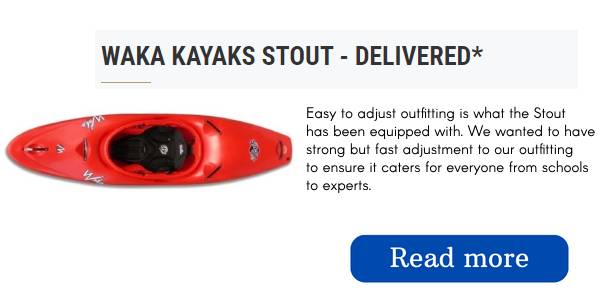A good way to store your kayak is to find a place where it will be safe and take up as little space as possible.
You will want your kayak to last a long time and be in good condition next time you go out on the water. All these can be achieved through proper storage.
Storing your kayak doesn’t have to be a difficult task. By following these simple guidelines, you can keep your kayak in good condition and make it easy to access when you need it.
You will also learn about kayaks and kayak storage tips, which may be useful for you.
Continue reading for more information!
What Is The Best Way To Store A Kayak?
You should store your kayak in a garage, inside the house, or any other sheltered place. If you live in a small house, the best option for getting more space is to find a well-sheltered place outside. All of the options require that the kayak be protected against harmful weather elements, such as heat and direct UV rays.
The kayak should be stored in a safe place, away from any other animals. You should check every so often to make sure there is no damage.
When you store your kayak properly, it will last longer, giving you more value for your money. The kayak is always ready for the next adventure. The wind and sun will take their toll on the kayak, which can cause it to degrade.
You shouldn’t leave your kayak tied to the top of your car for too long unless you’re planning to transport it. The wind and sun can damage the kayak over time.
Remember that distortion caused by improper storage is always caused by exposure to too much heat. Keep the boat in a garage or covered area to protect it from bad weather, direct sunlight, and other elements.
This is the best way to keep your kayak stored. If you’re looking for a way to store your kayak, you can try standing it on its stern against a wall and strapping it down to keep it from tipping over.
How Do I Store My Kayak In My Garage?
One of the safest places to store your kayak is in the garage. The kayak is often kept in the garage by leaning it against the wall in any corner. Some people do it by being pushed to the side. This could damage the boat and it is not safe.
There are more convenient ways to store your kayak inside your garage. Below are some of the simple tips:
Upright storage
Upright storage of kayaks is only recommended if you have two or fewer kayaks, or if the wall space available is minimal. Don’t worry—it’s affordable and easy to build a vertical storage unit.
To build vertical storage, you will need some boards and nails to help keep the structure together. The materials you will need for this project include: rubber kayak roofing, galvanized pipes, threaded pipes, rubber caps, oil pans with non-slip rubber bottoms, eye bolts, suspension cords, and foam rubber.
Talic sling set
Experts prefer storing their kayaks using the Talingsling set. It is ideal to mount the kayak horizontally on the wall to keep it off the ground and safe. The method is the best for sit-on-top kayaks as they have long straps that can stretch for up to 60 inches.
This is useful for tying down gear or even another kayak if you want to go on a tandem trip.
Only use the Taling sling set on your kayak if it weighs less than 100 pounds. However, setting up the Talic sling set is quick and easy with the following tools at hand:
1. Screwdriver
2. Drill
3. stainless steel screws (2 pieces)
To install the structure, you should follow the steps highlighted below:
Step 1: Determine the ideal height to mount the Talic string set for your kayak
Mark the points on the wall where you want the brackets to go and drill holes for each one.
Using the screws that came with the brackets, screw the brackets into the already drilled holes.
Step 2: Repeat step 1 for the other bracket
Close one bracket loop while keeping the other one opened.
Put your kayak in the closed strap.
To finish mounting the kayak, you should unbuckle one strap, put it inside the kayak, then buckle it again around the boat.
Verifying that the kayak is balanced at the center before leaving it stored.
Overhead suspension system
One popular and easy way to keep your kayak safe is to secure it with a rope. It is suitable for those who have a small garage or who have many kayaks that need to be stored. a pot, a knife, and some courage You only need a few things to use this method successfully – a pot, a knife, and some courage.
1. Two cambuckle tie-down straps
2. Four threaded eye bolts
The system for suspending kayaks overhead is easy to put together and is great for saving space. The following simple steps would help you to build the system effortlessly:
Measure the distance between the bulkheads and the kayak’s width.
Take the eyebolts and screw them into the corners.
On one side, take the straps and hook them onto the D-ring. Once done, wrap them around your kayak.
To keep the kayak from bowing in the middle, make sure that the straps are in the middle. The heaviest part of the kayak is usually the center, so strap it down carefully.
OUTDOOR STORAGE
If you don’t have a place to store your kayak inside, it’s no problem to keep it outside. Storing your kayak outdoors should only be done as a last resort option as it can be damaged by extreme temperatures, elements, and UV radiation.
If you are looking to store your kayak outdoors, your best bet is to find a shaded area. Most back porches or patios have some form of protection from the sun, wind, and extreme heat. If you have the space, you could even keep your kayaks stored under your porch.
You can hang your kayak from the ceiling using storage racks or suspension cords. If you store kayaks outdoors, it is recommended to loosen the tarp over the top. The tarp will keep your kayak dry during rainfall and snow, and will protect it from the sun’s rays.
IDEAL STORAGE OPTIONS
You’ve found the perfect place to store your kayak, now it’s time to find a solution that will fit your needs. Uneven weight distribution can damage a kayak, but using a storage rack or suspension system can help preventing this.
STORAGE RACK
There are two types of kayak storage racks: freestanding and those that are attached to a wall or ceiling. Some great examples are:
- Wall attached rack – Minimalist Paddle Board Wall Rack
- Freestanding rack – RAD Sportz Freestanding Storage Rack
- Ceiling rack – StoreYourBoard 2 Kayak Ceiling Storage Rack
SUSPENDED
Another option is to tie your kayak to the wall. When a kayak is taken out from a suspension storage system, the ropes sit flat against the wall, which is more streamlined than a storage rack.
Suspension systems are a lot cheaper than kayak racks because they are just ropes. This particular storage system can hold two kayaks that weigh a combined total of up to 200 lbs. It mounts easily to any wall using hooks.
INFLATABLE KAYAK STORAGE
When it comes to storage solutions, inflatable kayaks are the best. They can be stored in a small bag, under your bed, or neatly in the corner of a garage.
Once you’re done kayaking for the day, you can store your inflatable kayak in the same way as you would a hardshell kayak. Just make sure that it’s still inflated when you’re storing it. You should let some air out of your kayak if you plan to store it while it is inflated.
This will give the air inside the kayak space to expand. It’s best to fully deflate your kayak and store it in a dry place if you’re not going to use it for a long period of time.
HOW TO STORE A KAYAK
Now that we’ve discussed different ways to store kayaks, let’s go over how to store a kayak correctly.
CLEAN IT THOROUGHLY
To store your kayak, you will first need to clean it. If you use your kayak regularly, you can rinse it with fresh water after each use to clean it. We recommend cleaning your kayak with a mild soap before storing it away for a long period of time, such as over the winter.
You should take more care than usual when cleaning your kayak if you’ve just paddled in salt water. It is important to rinse your kayak with fresh water after paddling in salt water in order to prevent damage to the kayak.
Salt water can damage both hardshell and inflatable kayaks, so it is important to remove any salt water or debris from the kayak’s hull and cockpit by rinsing it off thoroughly.
DRY IT PROPERLY
Rinse or wash your kayak as usual, then dry it off completely. To dry your wet phone, leave it outside for five to ten minutes, then dry it off with a towel.
It’s not a good idea to store your kayak while it’s wet, because that can encourage the growth of mold and mildew, especially on fabric components like the kayak seat.
CHECK FOR ANY DAMAGE
It’s a good idea to thoroughly inspect your kayak for any damage while you’re washing and drying it. Although kayaks are durable and can withstand hitting rocks or other debris in the water, this type of impact can cause serious damage.
If you notice any damage to your kayak, it is best to have a professional fix it as soon as possible. The mistake of ignoring potential damage to your kayak can ruin it beyond repair.
DISTRIBUTE THE WEIGHT OF THE KAYAK
If you have a plastic kayak, you need to think about distributing the weight evenly. You should not store your kayak vertically against a wall as all the weight of the kayak will be concentrated on the kayak’s nose or tail.
This is also true for when you lay the kayak on a flat surface. As the bottom of the kayak is more prominent than other parts, all the kayak’s weight will be centered on one particular area. This will cause pressure indents and shorten your kayaks overall lifespan over time.
ADD UV PROTECTION
It’s important to keep your kayak out of the sun to prevent it from getting damaged.
Although kayaks are made to be used outdoors, they, like other personal watercraft, will not last long if left outside in the elements. The sun’s rays can deterioration the kayak’s materials and can also cause discoloration, making your kayak look old and outdated.
You should store your kayak in a shaded area to protect it from the sun, and you can add a tarp or kayak cover for an extra layer of protection.
STORE YOUR KAYAK ACCESSORIES
Although your kayak may be the most expensive item in your collection, you should take care of all your gear and accessories.
This means that everything you do to your kayak should be done to your kayak gear as well. This means that anything you need to go kayaking, like paddles and kayak clothing, as well as seats and other accessories, is included.
Make sure to check your gear over for any tears, rips, or dents before storing it. After you check that they are healthy and not sick, rinse them off with fresh water and let them dry.
Make sure everything is dry before you store it with your kayak. This way nothing will get lost, moved, or broken. We suggested that you should have a bag or drawer only for your gear so it would not be moved around and would stay in the same place while being stored.




